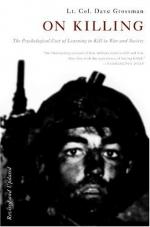
|
| Name: _________________________ | Period: ___________________ |
This test consists of 5 short answer questions, 10 short essay questions, and 1 (of 3) essay topics.
Short Answer Questions
1. In Chapter 3, Grossman says the western-style shooting games are similar to what?
2. In Chapter 2, what is a socially humiliating act regarding modern media?
3. What does Grossman credit with reducing the number of homicides in America in Chapter 1?
4. Which of the following theorists presents evidence concerning tactical attractiveness of a victim?
5. What mistaken impression did the ex-CIA officer whose story appears at the end of Chapter 1 have about his prisoner?
Short Essay Questions
1. What examples from Chapter 6 illustrate a problematic relationship with women in the military?
2. What factors does Grossman say are contributing to youth violence in Chapter 1?
3. What surprising insight into Vietnam does RB Anderson make in Chapter 1?
4. What hypothetical situation does Grossman relate in Chapter 3?
5. As described in Chapter 2, how do children progress through increasingly violent entertainment?
6. In Chapter 2, what does Grossman say an atrocity does to a combat unit's group dynamic?
7. In Chapter 5, how does Grossman illustrate the danger of refusing to take part in an atrocity?
8. Describe the strange story of the CIA guard at the end of Chapter 1?
9. What changes have occurred in recent years to mitigate the psychiatric casualties of Vietnam?
10. According to Grossman in Chapter 3, what is the difference between military killing training and that provided by video games?
Essay Topics
Write an essay for ONE of the following topics:
Essay Topic 1
Much of Grossman's book is dedicated to explaining how the Vietnam War was rifer with psychiatric casualties than any previous war. Write an essay comparing the Vietnam conflict to previous conflicts in several regards. What factors were in play that made it more detrimental to servicemen? What support did they lack, on the whole? In essence, how did these failings manifest themselves, and have they since been addressed?
Part 1) Unit cohesion
Part 2) Mature, experienced leadership
Part 3) Public validation upon return
Essay Topic 2
Perhaps the centerpiece of Grossman's research, the killing process, through which the author explains how a person chooses to kill and then processes the killing - or inability to kill - after, is the subject of most of the second half of the book. Write a three-part essay about this process:
Part 1) Begin the essay by discussing the steps in the killing process. Where does it begin and, ideally, how does a killer resolve the act and its emotional repercussions? Must a killer go through all of the steps in the process?
Part 2) Using the fallout of the Vietnam War as a model, discuss what happens when the latter steps of the process are stunted? What factors are key in allowing a killer to rationalize and accept that he has killed? How were these denied to Vietnam vets?
Part 3) At one point in ON KILLING, Dave Grossman applies the killing process to an entire culture, namely America after two wars of the twentieth century. Discuss the way America collectively processed killing after Hiroshima and the first Gulf War. How did this process affect American leadership?
Essay Topic 3
Throughout the book, Grossman has argues that conditioning has been the key to increasing shooting rates in combat zones. It bypasses the conscious mind's inclination to avoid killing. Write a three-part essay analyzing the types of conditioning used in a military context:
Part 1) What is standard conditioning, and how is it connected to Pavlov's work with dogs? How does this type of conditioning manifest itself in military training? What specific defenses is it trying to overcome? What is its goal?
Part 2) What is operant conditioning, and how is it connected to Skinner's work with rats? To what extent is military operant training more subtly employed than traditional conditioning? How does this conditioning alter soldier behavior in chaotic combat?
Part 3) In military emulation of a role model, who is the standard soldier's role model? What does this role model represent to the soldier, and how does he wish to emulate him? What aspects of aggression and manhood does this affect?
|
This section contains 1,300 words (approx. 5 pages at 300 words per page) |

|




